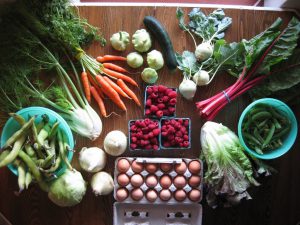 The farm is dirty. Food comes with the leaves attached. Bugs are crawling on things. It makes me very aware that we are not just eating vitamins and flavor, but real, living plants.
The farm is dirty. Food comes with the leaves attached. Bugs are crawling on things. It makes me very aware that we are not just eating vitamins and flavor, but real, living plants.
We all start somewhere: with a Happy Meal, with a microwave dinner, mixing up a package of Hamburger Helper. I’ve used all of the above in my not-so-distant past as staples in my daily eating rituals. However, the more I stopped and looked at what I was eating, the more I came to explore and appreciate the food I ate. In order to have passion about food, you must first stop and pay attention to what you eat.
We moved away from boxes and tubes into the land of grocery vegetables, bagging all our freshly spritzed produce. Paying attention to the curves and colors, we chose our produce based on how shiny and perfect it looked. Yearning for fresher, more local options, we went to farmers markets, and ogled the unwaxed fruit, coming to appreciate the true luster of food. We saw ugly veggies and were surprised at how delectable they could be. The more we learned about our food, its nature and its origin, the more we came to appreciate the food we ate, and the more passionate we became about learning more.
The farm is food’s home. Plants come from the soil. They are alive. They photosynthesize. They bloom and bear fruit. Their roots go deep. Why is it important to be able to know the true shape of the food you eat? Why is a world of wonky red spheres (like heirloom tomatoes), orange tubes with bushy heads (carrots) and light green flower/flying saucers (summer squash) better than a world full of cardboard boxes and plastic bags?
First of all: Food is beautiful.
Second: When you let yourself encounter the true face of things, you see that life is more diverse and surprising than you ever could have imagined.
Lastly: You discover that what you eat is at its best when it’s imperfect. Tasty foods are often ugly or dirty, or covered in the leaves, roots or stalks that are apart of them.
I would go so far as to say that people are the same.
 WEEK 4
WEEK 4
(bottom left)
– Big bowl of Fava Beans
– Head of Cabbage
– 3 Onions, from Walla Walla, WA
(going counter-clockwise and up around the top)
– Fennell
– Carrots
– 2 kinds of Summer Squash
– 3 Kohlrabi
– Red Chard
– Bowl of Sugar Snap Peas
– Head of Lettuce
(plus)
– 3 cups of Raspberries
– The farm has new hens, and they are laying smaller eggs this week, so we received 18 eggs instead of the normal dozen
*Turnip photo courtesy of Stephen Proctor.
By ekwetzel
2010-07-30

I don’t know what kohirabo is, but I will find out. I have, however, learned a lot about my own food history and orientation from having finished Kingsolver’s book, “Animal, Mineral, Miracle”. Over time, many important food facts that she stressed in her book, I have known and lived, have buried deep and not held fast to, but would now like to come back to them. We shall see…
I’m not sure what kohirabo is either! ^_^ Do you mean kohlrabi, by any chance? ( http://en.wikipedia.org/wiki/Kohlrabi ) You can cook it up like mashed potatoes, and it kind of tastes like cauliflower, with a texture closer to potatoes.